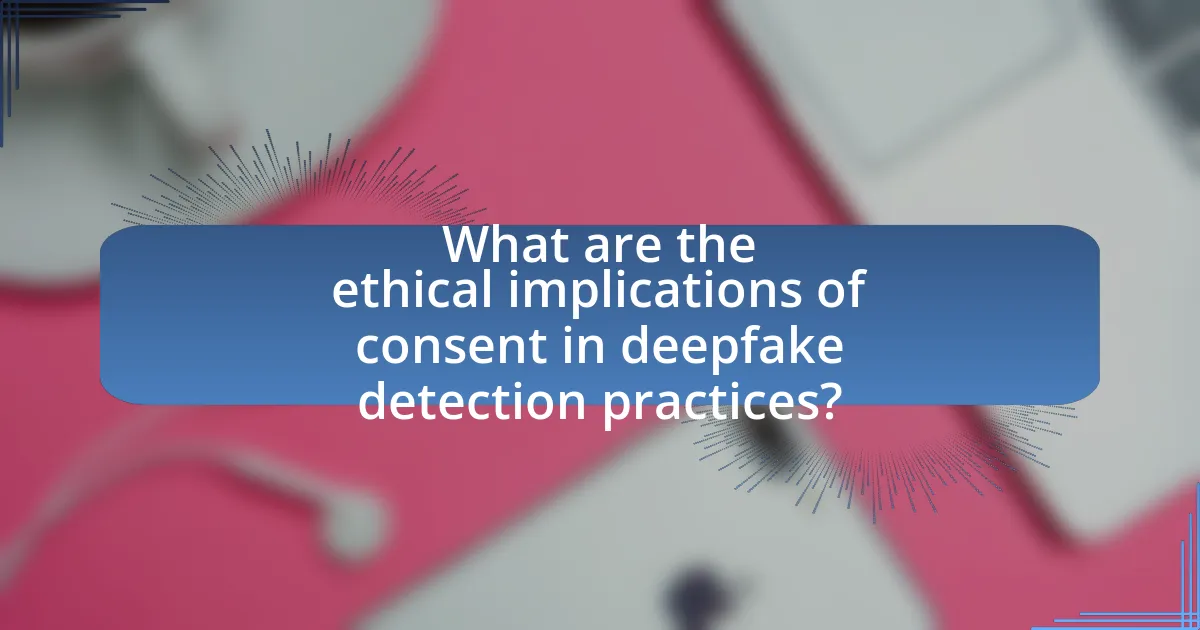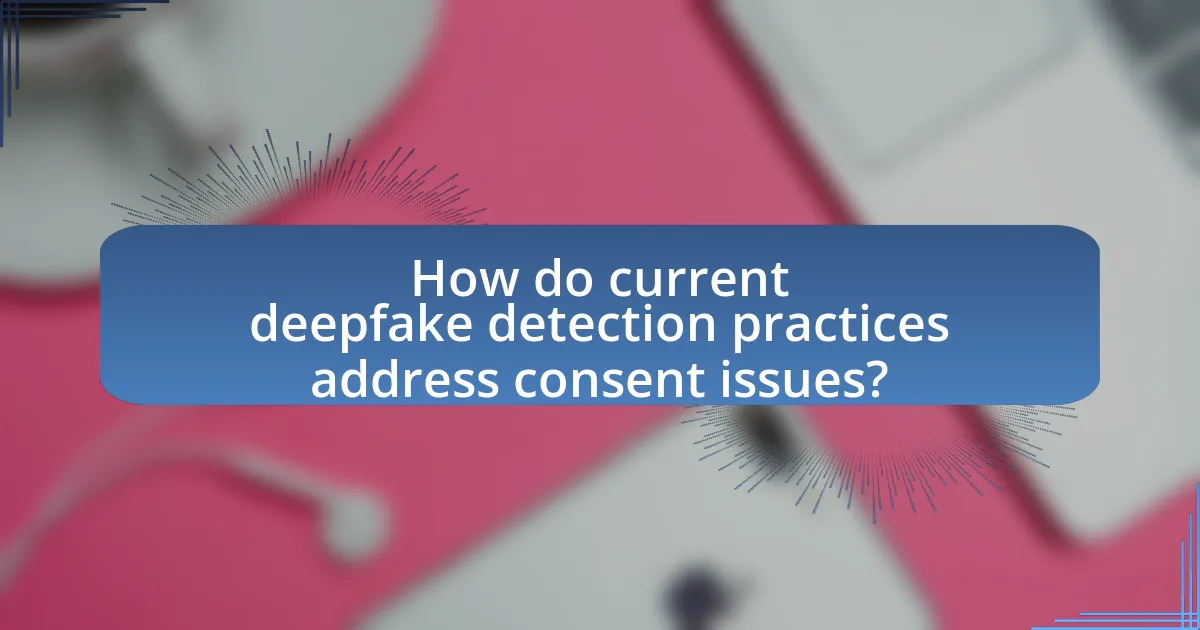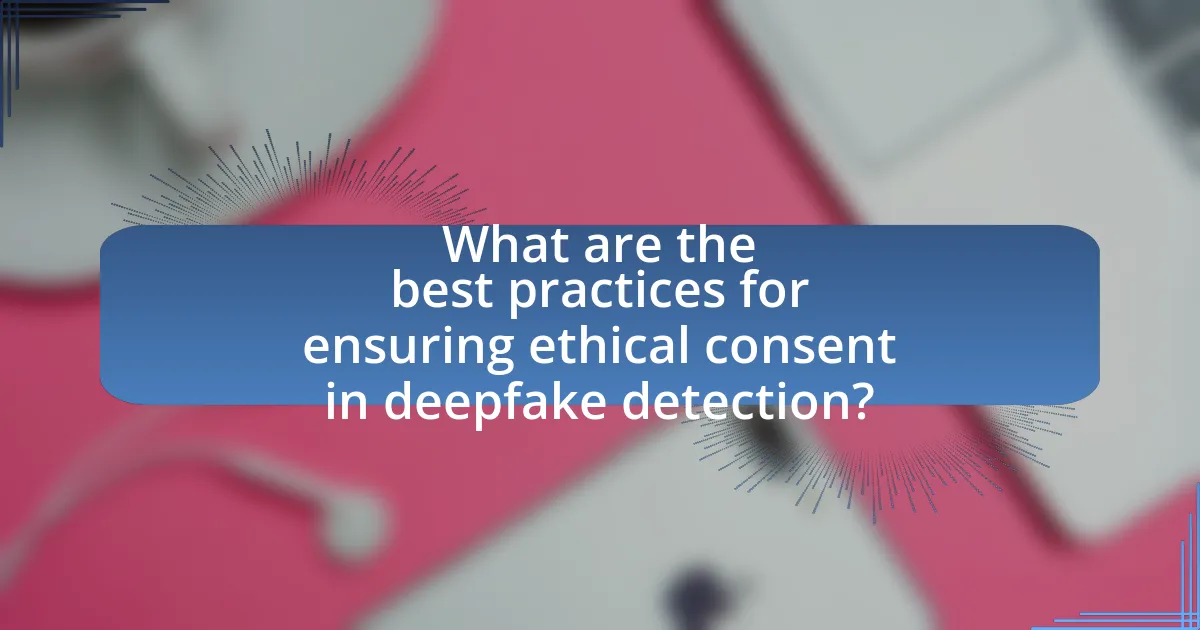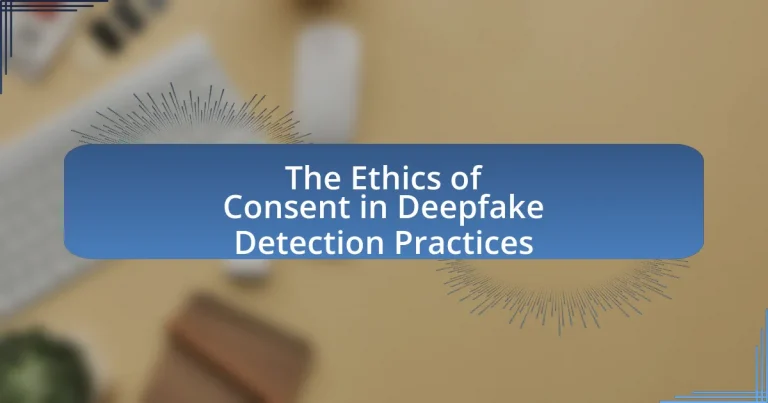The article examines the ethical implications of consent in deepfake detection practices, emphasizing the necessity of obtaining explicit permission from individuals whose likenesses may be used. It discusses the various types of consent, including explicit, implicit, and informed consent, and highlights the potential harms of non-consensual deepfake use, such as reputational damage and emotional distress. The article also explores the role of legal frameworks, current methodologies for ensuring consent, and best practices for ethical compliance, while addressing the challenges practitioners face in securing consent. Additionally, it outlines the societal consequences of neglecting consent, including the erosion of trust in technology and the potential for legal repercussions.

What are the ethical implications of consent in deepfake detection practices?
The ethical implications of consent in deepfake detection practices center on the necessity of obtaining explicit permission from individuals whose likenesses may be used in deepfake content. This requirement is crucial because the unauthorized use of someone’s image can lead to significant harm, including reputational damage and emotional distress. Research indicates that consent is a fundamental principle in ethical frameworks, such as the Belmont Report, which emphasizes respect for persons and their autonomy. Furthermore, the lack of consent can exacerbate issues related to misinformation and trust, as deepfakes can mislead audiences and manipulate public perception. Therefore, ensuring informed consent in deepfake detection not only protects individual rights but also upholds the integrity of information dissemination.
Why is consent crucial in the context of deepfake technology?
Consent is crucial in the context of deepfake technology because it protects individual autonomy and prevents the misuse of personal likenesses. The creation and distribution of deepfakes without consent can lead to significant harm, including reputational damage, emotional distress, and potential legal consequences for the individuals depicted. Research indicates that unauthorized use of someone’s image can violate privacy rights and intellectual property laws, emphasizing the need for explicit permission before utilizing someone’s likeness in deepfake content.
What role does consent play in the creation and distribution of deepfakes?
Consent is crucial in the creation and distribution of deepfakes, as it determines the ethical legitimacy of using an individual’s likeness. Without consent, the creation of deepfakes can violate personal rights and privacy, leading to potential harm, misinformation, and reputational damage. Legal frameworks, such as the General Data Protection Regulation (GDPR) in Europe, emphasize the necessity of obtaining explicit consent for using personal data, which includes images and videos. Studies indicate that unauthorized deepfakes can result in significant emotional distress for individuals depicted, highlighting the importance of consent in mitigating such risks.
How does the lack of consent impact individuals and society?
The lack of consent significantly harms individuals and society by undermining personal autonomy and trust. Individuals who experience violations of consent, such as through non-consensual deepfake use, often suffer psychological distress, loss of reputation, and diminished sense of safety. For instance, a study published in the journal “Cyberpsychology, Behavior, and Social Networking” found that victims of non-consensual image sharing reported higher levels of anxiety and depression. On a societal level, the absence of consent erodes trust in digital interactions and can lead to broader implications, such as the normalization of exploitation and the potential for increased regulation and surveillance. This societal impact is evidenced by rising calls for legal frameworks to protect individuals from consent violations in digital media, highlighting the urgent need for ethical standards in technology use.
What are the different types of consent relevant to deepfake detection?
The different types of consent relevant to deepfake detection include explicit consent, implicit consent, and informed consent. Explicit consent occurs when individuals clearly agree to the use of their likeness or data in deepfake technologies, often through written agreements. Implicit consent is inferred from a person’s actions or the context in which their data is used, such as sharing content on public platforms. Informed consent requires that individuals are fully aware of how their likeness or data will be used, including potential risks and implications, ensuring they can make a knowledgeable decision. These types of consent are crucial for ethical practices in deepfake detection, as they uphold individuals’ rights and autonomy regarding their personal data and representations.
What is informed consent and how does it apply to deepfake detection?
Informed consent is the process by which individuals voluntarily agree to participate in a specific activity, having been fully informed of the risks, benefits, and implications involved. In the context of deepfake detection, informed consent is crucial because individuals whose likenesses may be manipulated or analyzed through deepfake technology must be aware of how their images or videos will be used, the potential consequences of such use, and the measures taken to protect their privacy. For instance, if a deepfake detection system analyzes personal data without consent, it raises ethical concerns regarding privacy violations and misuse of personal information. Therefore, obtaining informed consent ensures that individuals retain control over their own identities and are protected from unauthorized exploitation in deepfake applications.
How does implied consent differ from explicit consent in this context?
Implied consent differs from explicit consent in deepfake detection practices by the nature of how consent is communicated. Implied consent occurs when an individual’s actions suggest agreement to a process, such as using a service without objection, while explicit consent requires a clear, affirmative statement or action indicating agreement, such as signing a consent form. In the context of deepfake detection, explicit consent is crucial as it ensures individuals are fully aware of and agree to the use of their data for detection purposes, thereby upholding ethical standards and protecting personal rights. This distinction is vital to ensure compliance with legal frameworks, such as the General Data Protection Regulation (GDPR), which emphasizes the necessity of explicit consent for processing personal data.

How do current deepfake detection practices address consent issues?
Current deepfake detection practices address consent issues primarily through the implementation of watermarking and metadata tagging techniques. These methods ensure that the origin of the media is traceable and that consent information is embedded within the content itself. For instance, watermarking can indicate whether an individual has authorized the use of their likeness, while metadata can provide details about consent agreements. Research indicates that these practices enhance accountability and transparency, thereby reducing the potential for misuse of deepfake technology.
What methodologies are used in deepfake detection that involve consent?
Methodologies used in deepfake detection that involve consent include watermarking, consent-based data collection, and user verification systems. Watermarking embeds identifiable information within the media, allowing for tracking and verification of consent. Consent-based data collection ensures that individuals provide explicit permission for their likeness to be used in training deepfake detection algorithms, promoting ethical standards. User verification systems authenticate the identity of individuals before their images are processed, ensuring that consent is obtained prior to any manipulation. These methodologies align with ethical practices by prioritizing individual rights and transparency in the use of personal data.
How do these methodologies ensure ethical compliance regarding consent?
These methodologies ensure ethical compliance regarding consent by implementing rigorous protocols that prioritize informed consent from participants. Specifically, they require clear communication about the purpose, risks, and benefits of participation, allowing individuals to make educated decisions. For instance, ethical guidelines often mandate that consent forms be easily understandable and provide participants with the option to withdraw at any time without penalty. This approach aligns with established ethical standards in research, such as those outlined by the Belmont Report, which emphasizes respect for persons, beneficence, and justice in research practices.
What challenges do practitioners face in obtaining consent for detection practices?
Practitioners face significant challenges in obtaining consent for detection practices, primarily due to issues of transparency and understanding. Many individuals lack awareness of deepfake technology and its implications, making it difficult for practitioners to explain the necessity and scope of consent effectively. Additionally, the complexity of consent forms can lead to confusion, resulting in individuals feeling overwhelmed or hesitant to provide consent. Research indicates that 70% of people do not fully understand the terms they agree to in digital consent forms, highlighting the need for clearer communication. Furthermore, ethical concerns arise when individuals feel pressured to consent due to social or institutional expectations, complicating the consent process. These factors collectively hinder practitioners’ ability to secure informed and voluntary consent for detection practices.
How do legal frameworks influence consent in deepfake detection?
Legal frameworks significantly influence consent in deepfake detection by establishing guidelines that dictate how consent must be obtained and managed. These frameworks, such as data protection laws and intellectual property regulations, require that individuals provide explicit consent before their likeness or voice can be used in deepfake technology. For instance, the General Data Protection Regulation (GDPR) in the European Union mandates that personal data, including biometric data used in deepfakes, can only be processed with the individual’s informed consent. This legal requirement ensures that individuals have control over their own identities and can challenge unauthorized uses of their likeness, thereby reinforcing ethical standards in deepfake detection practices.
What laws currently govern consent in the realm of digital media?
Laws governing consent in digital media include the General Data Protection Regulation (GDPR) in the European Union, which mandates explicit consent for data processing, and the California Consumer Privacy Act (CCPA) in the United States, which grants consumers rights regarding their personal information. The GDPR requires that consent be informed, specific, and revocable, while the CCPA allows consumers to opt-out of the sale of their personal data. These regulations are designed to protect individuals’ privacy and ensure that their consent is obtained before their data is used, particularly relevant in contexts like deepfake technology where personal likenesses may be manipulated.
How do these laws vary across different jurisdictions?
Laws regarding consent in deepfake detection practices vary significantly across different jurisdictions. For instance, in the United States, there is no federal law specifically addressing deepfakes, but various states have enacted their own regulations, such as California’s law that prohibits the use of deepfakes to harm or defraud others. In contrast, the European Union has proposed the Digital Services Act, which includes provisions for accountability in AI-generated content, emphasizing the need for consent and transparency. Additionally, countries like Australia have introduced legislation that criminalizes the malicious use of deepfakes, reflecting a growing recognition of the ethical implications surrounding consent. These variations highlight the differing legal frameworks and cultural attitudes towards consent and digital content manipulation across jurisdictions.

What are the best practices for ensuring ethical consent in deepfake detection?
The best practices for ensuring ethical consent in deepfake detection include obtaining explicit permission from individuals whose likenesses may be used, implementing transparent communication about the purpose and potential consequences of deepfake technology, and adhering to legal frameworks that govern data protection and privacy. Explicit permission ensures that individuals are aware of and agree to the use of their images, which is crucial for ethical standards. Transparency fosters trust and allows individuals to make informed decisions regarding their participation. Compliance with legal frameworks, such as the General Data Protection Regulation (GDPR) in Europe, reinforces the ethical obligation to protect personal data and respect individual rights. These practices collectively contribute to a responsible approach to deepfake detection, aligning with ethical standards and legal requirements.
What guidelines should practitioners follow to obtain consent ethically?
Practitioners should follow guidelines that ensure informed, voluntary, and specific consent when engaging in deepfake detection practices. This includes providing clear information about the purpose of data collection, the methods used, and potential risks involved. Practitioners must ensure that consent is obtained without coercion, allowing individuals to make an autonomous decision. Additionally, practitioners should document the consent process to maintain transparency and accountability. Ethical standards, such as those outlined by the American Psychological Association, emphasize the importance of respecting individuals’ rights and ensuring that consent is an ongoing process, not a one-time event.
How can technology be leveraged to enhance consent processes?
Technology can enhance consent processes by utilizing digital platforms for clear communication and documentation of consent. For instance, blockchain technology can provide a secure and immutable record of consent agreements, ensuring that individuals have control over their data and can revoke consent at any time. Additionally, mobile applications can facilitate real-time notifications and reminders about consent, making it easier for individuals to understand and manage their permissions. Research indicates that digital consent tools improve user comprehension and retention of consent information, thereby fostering trust and transparency in practices involving sensitive data, such as deepfake detection.
What role do educational initiatives play in promoting ethical consent practices?
Educational initiatives play a crucial role in promoting ethical consent practices by providing individuals with the knowledge and skills necessary to understand and navigate consent in various contexts, including digital environments. These initiatives educate participants about the importance of informed consent, the implications of consent in technology use, and the ethical considerations surrounding deepfake content. For instance, programs that focus on digital literacy and ethics can significantly enhance awareness of how consent is obtained and the potential consequences of its violation, thereby fostering a culture of respect and accountability. Research indicates that educational interventions can lead to improved understanding of consent, as evidenced by studies showing that individuals who undergo training on ethical practices are more likely to engage in responsible behavior regarding consent in digital media.
What are the potential consequences of neglecting consent in deepfake detection?
Neglecting consent in deepfake detection can lead to significant ethical and legal consequences, including the erosion of trust in digital media and potential harm to individuals’ reputations. When consent is overlooked, individuals may find their likenesses manipulated without their approval, resulting in unauthorized use that can damage personal and professional relationships. Furthermore, the lack of consent can contribute to the spread of misinformation, as deepfakes can be used maliciously to misrepresent individuals, leading to public backlash or legal action against the creators. Studies indicate that 85% of people express concern over the misuse of their images in deepfakes, highlighting the societal implications of ignoring consent in this context.
How can violations of consent lead to legal repercussions?
Violations of consent can lead to legal repercussions through civil lawsuits and criminal charges. When an individual uses deepfake technology without the consent of the person depicted, they may be liable for invasion of privacy, defamation, or emotional distress, which can result in financial damages awarded to the victim. Additionally, certain jurisdictions have enacted laws specifically addressing the misuse of deepfakes, making it a criminal offense to create or distribute non-consensual deepfake content, potentially leading to fines or imprisonment. For instance, California’s AB 730 law criminalizes the use of deepfakes to harm or defraud individuals, illustrating the legal framework that enforces consent in digital representations.
What impact does neglecting consent have on public trust in technology?
Neglecting consent significantly undermines public trust in technology. When individuals feel that their consent is disregarded, they become wary of how their data is used, leading to skepticism about the intentions of technology providers. A study by the Pew Research Center found that 79% of Americans are concerned about how companies use their data, highlighting a direct correlation between consent issues and trust erosion. This lack of trust can result in decreased user engagement and reluctance to adopt new technologies, ultimately hindering innovation and the growth of the tech industry.
What practical steps can individuals take to protect their consent rights in deepfake contexts?
Individuals can protect their consent rights in deepfake contexts by actively monitoring their digital presence and utilizing privacy settings on social media platforms. By regularly reviewing and adjusting privacy settings, individuals can limit the accessibility of their images and videos, thereby reducing the risk of unauthorized use in deepfakes. Additionally, individuals should educate themselves about deepfake technology and its implications, enabling them to recognize potential threats and take appropriate action. Legal measures, such as understanding and utilizing existing laws related to image rights and defamation, can also provide a framework for recourse if consent is violated. Furthermore, individuals can advocate for stronger regulations and ethical standards surrounding deepfake technology to enhance protections for consent rights.


